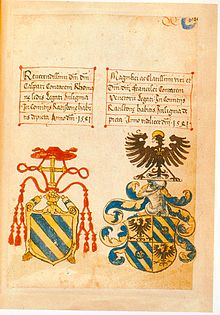Gasparo Contarini

Gasparo Contarini (born October 16, 1483 in Venice , † August 24, 1542 in Bologna ) was a Venetian diplomat and later a cardinal of the Roman Church .
Life
Gasparo Contarini came from the Venetian noble family of Contarini and was probably born in the Palazzo Contarini dal Zaffo . After spending time in school in Venice, he studied Greek, mathematics, philosophy and theology at the University of Padua from 1501 to 1509 . After completing his studies, he returned to Venice, where he was entrusted as a member of the Grand Council with an office responsible for the administration of the national debt. 1520 was sent to the Diet of Worms as a representative of Venice . He was involved in the peace treaty of 1523 with Emperor Charles V , whom he then accompanied on his travels to the Netherlands, England and Spain.
In 1525 he returned to Venice and took over the office of savio der terraferma . In 1527 he represented the republic in the Holy League of Cognac , an alliance directed against the emperor's hegemony, but which fell apart in the wake of the Sacco di Roma . Contarini played a key role in the peace agreement between the emperor and Venice in January 1530 in Bologna. After his return to Venice he held several high offices there.
In the consistory of May 21, 1535 the lay Contarini of Pope Paul III. created cardinal and shortly thereafter elevated first to cardinal deacon , then cardinal priest of the titular deaconry Santa Maria in Aquiro . The minor orders issued to him Gian Carlo Carafa, later followed the ordination . In the same year he was appointed cardinal priest of the titular church of San Vitale , and a year later he was appointed bishop of the diocese of Belluno . He was ordained bishop on February 17, 1538 in the Sistine Chapel by Pope Paul III. himself. Cardinal Contarini's appointment as chairman of a commission that was supposed to work out proposals for an internal reform of the church was of particular importance. This commission included the cardinals Gian Carlo Carafa, who later became Pope Paul IV , as well as Giovanni Morone , Reginald Pole , Pietro Bembo , Peter Martyr Vermigli and the humanist Marcantonio Flaminio . In the document Consilium de emendanda ecclesia of 1537 prepared by the commission , the Pope was advised not to abuse his power and to better monitor the bishops, their dioceses and their clergy . However, the recommendations fizzled out. In 1537 Cardinal Contarini received the titular church of Santa Balbina , in 1539 he moved to Sant 'Apollinare .

In 1541, at the express request of Charles V, he was sent as a papal legate to the Regensburg Religious Discussion , where he was supposed to prepare a document on an agreement between Protestants and Catholics. Despite all the efforts and diplomatic skill of Contarini and Philipp Melanchthon , the Protestant representative, the project turned out to be hopeless, as both parties did not want an agreement. In 1542, the year of his death, he moved to the titular church of Santa Prassede .
Works
- De magistratibus et republica Venetorum.
- De potestate Pontificis. 1529.
- Confutatio articulorum seu quaestionum Lutheri. after 1530.
- Tractatus seu Epistola de iustificatione. 1541.
- De magistratibus et republica veneta. Paris 1543.
- De sacramentis christianae legis et catholicae ecclesiae. Florence 1553.
- Opera. Paris 1571.
Individual evidence
- ↑ J.-Ch. Rößler: Palazzo Contarini dal Zaffo (accessed on October 2, 2016)
literature
Lexicons
- C. Weizsäcker, Th. Brieger: Contarini, Gasparo . In: Realencyklopadie for Protestant Theology and Church (RE). 3. Edition. Volume 4, Hinrichs, Leipzig 1898, pp. 278-281.
- Francis Schaefer: Gasparo Contarini . In: Catholic Encyclopedia , Volume 4, Robert Appleton Company, New York 1908.
- Friedrich Wilhelm Bautz : CONTARINI, Gasparo, statesman and cardinal. In: Biographisch-Bibliographisches Kirchenlexikon (BBKL). Volume 1, Bautz, Hamm 1975. 2nd, unchanged edition Hamm 1990, ISBN 3-88309-013-1 , Sp. 1119-1120.
- Klaus Ganzer : Contarini, Gasparo . In: Theologische Realenzyklopädie (TRE). Volume 8, de Gruyter, Berlin / New York 1981, ISBN 3-11-008563-1 , pp. 202-206.
- Gigliola Fragnito: Contarini, Gasparo. In: Alberto M. Ghisalberti (Ed.): Dizionario Biografico degli Italiani (DBI). Volume 28: Conforto-Cordero. Istituto della Enciclopedia Italiana, Rome 1983.
Monographs
- Beccadelli: Vita del Cardinal Gasparo Contarini. Venice 1832.
- Hubert Jedin : Cardinal Contarini as a controversial theologian (= Catholic life and fighting in the age of religious schism. Vol. 9). Munster 1949.
- Manfred E. Welti: Brief history of the Italian Reformation (= writings of the Association for Reformation History . Vol. 193). Mohn, Gütersloh 1985, ISBN 3-579-01663-6 , pp. 17-138 ( digitized in the Google book search).
- Elisabeth G. Gleason: Gasparo Contarini: Venice, Rome, and Reform. University of California Press, Berkeley 1993.
- Claus Arnold: The Roman censorship of the works of Cajetans and Contarini (1558-1601). Limits of theological confessionalization. Ferdinand Schöningh, Paderborn 2008, ISBN 978-3-506-76437-9 .
Web links
- Contarini, Gasparo. In: Salvador Miranda : The Cardinals of the Holy Roman Church. ( Florida International University website, English)
- Entry on Gasparo Contarini on catholic-hierarchy.org
- Literature by and about Gasparo Contarini in the catalog of the German National Library
| personal data | |
|---|---|
| SURNAME | Contarini, Gasparo |
| ALTERNATIVE NAMES | Contarini, Gaspare |
| BRIEF DESCRIPTION | Venetian diplomat, later cardinal of the Roman Church |
| DATE OF BIRTH | October 16, 1483 |
| PLACE OF BIRTH | Venice |
| DATE OF DEATH | August 24, 1542 |
| Place of death | Bologna |

